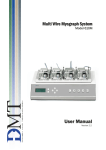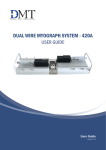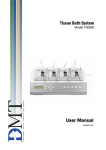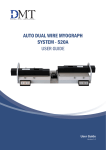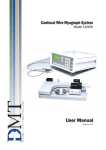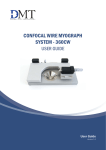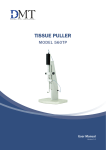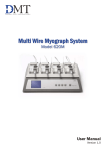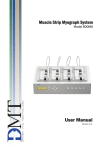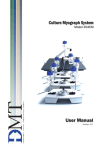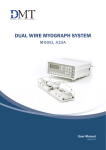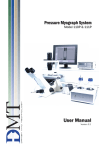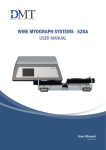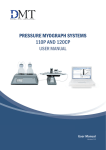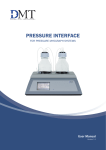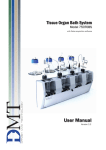Download User Manual
Transcript
Single Myograph System Model 310A User Manual Version 3.3 Single wire myograph system Model 310A Single Wire Myograph System - model 310A User manual Trademarks PowerLab® and LabChart® are registered trademarks of ADInstruments Pty Ltd. The names of specific recording units, such as PowerLab 4/25, are trademarks of ADInstruments Pty Ltd. Pentium is a registered trademark of the Intel Corporation. Windows, Windows 95, Windows 98, Windows ME, Windows NT, Windows 2000, Windows XP and Vista are registered trademarks of Microsoft Corporation. All other trademarks are the properties of their respective owners. DMT reserves the right to alter specifications as required. This document was, as far as possible, accurate at the time of printing. Changes may have been made to the software and hardware it describes since then. New information may be supplied separately. This documentation is provided with the DMT Single wire myograph system – Model 310A – v. 3.3 Document Number: 310A – UG3.3A No part of this document may be reproduced by any means without the prior written permission of DMT. Copyright © 2008 DMT A/S DMT A/S Skejbyparken 152 DK-8200 Aarhus N Denmark Tel.: +45 87 41 11 00 Fax: +45 87 41 11 01 www.dmt.dk [email protected] [email protected] DMT - Asia Everwin Gardens Rm 502, Block B 521 Wanping Nan Lu Shanghai 200030 China Tel: + 86 (0) 21 64869685 Fax: + 86 (0) 21 64280591 www.dmt-asia.com [email protected] [email protected] DMT-USA, Inc. 1201 Peachtree Street 400 Colony Square, Suite 200-630 Atlanta, GA 30361 USA Tel.: +1 770 612 8014 Fax: +1 678 302 7013 www.dmt-usa.com [email protected] [email protected] User manual 310A Trademarks Introduction Until the mid-1970s most of the details about the mechanical, morphological and pharmacological properties of vascular smooth muscle was obtained from studies on relatively large vessels. At that time, rat tail arteries were the smallest vessels to be investigated in detail due to limitations in the available in vitro techniques. For example, studies measuring the contraction force were routinely performed with only one of the mounting wires secured. Furthermore, relatively large wires (100–200 μm) were used, which precluded the use of small vessels, and the vessel segment had to be directly manipulated with the dissecting equipment causing inevitable mechanical trauma. Investigations of smaller vessels were therefore limited to in vivo perfusion experiments and histological examinations. In 1976, Professors Mulvany and Halpern described for the first time a new technique that made it possible to investigate highly-isometric responses from vessels with internal diameters as small as 100 μm. The mounting procedure was refined twofold: both ends of each mounting wire were secured under tension without any direct manipulation of the vessel segment. Segments of small vessels could now be atraumatically mounted as ring preparations in a myograph for recording of highly isometric force measurements. During the late 1970s some improvements were made to the myograph and in 1981 a new dual myograph that allowed simultaneous testing of two vessels was introduced. In parallel, the technique became widely acknowledged resulting in a growing interest in the myograph systems. In 1986, the growing demand resulted in the foundation of the private company J.P. Trading with the purpose of making the myograph systems commercially available worldwide. At the same time J.P. Trading initiated a comprehensive improvement programme for the existing myograph systems as well as a development programme of new myograph systems in close cooperation with Professor M. J. Mulvany and the University of Aarhus. During the late 1980s and through the 1990s several improvements were applied to the myograph systems, such as a new mechanical design, a more robust transducer and new electronic systems. In addition, new systems were introduced, like the Automatic Dual Myograph 510A, the Dual Myograph 410A, the Multi Myograph 610M and the Confocal Myograph 120CW. In 2000 J.P. Trading changed its company structure and became known as DMT. Today DMT is one of the world’s leading designers and manufacturers of wire myographs, pressure myographs, culture myographs and organ/tissue baths. Driven by our global customer base, our number one goal is to develop and manufacture first class research equipment within the fields of physiology and pharmacology. Single wire myograph system Model 310A Safety The Single Wire Myograph System has been designed for use only in teaching and research applications. It is not intended for clinical or critical life-care use and should never be used for these purposes: nor for the prevention, diagnosis, curing, treatment, or alleviation of disease, injury, or handicap. • Do not open the unit: the internal electronics pose a risk of electric shock. • Do not use this apparatus near water. • To reduce the risk of fire or electric shock, do not expose this apparatus to rain or moisture. Objects filled with liquids should not be placed on the apparatus. • Do not block any ventilation openings. Install in accordance with the manufacturer’s instructions. • Do not install near any heat sources such as radiators, heat registers, stoves, or other apparatus that produce heat. • Only use attachments and accessories specified by the manufacturer. • Unplug this apparatus during lightning storms or when unused for long periods of time. • This apparatus must be grounded. • Use a three-wire grounding-type cord similar to the one supplied with the product. • Do not defeat the safety purpose of the polarized or grounding-type plug. A polarized plug has two flat blades, one being wider than the other. A grounding type plug has two blades and a third (round) grounding pin. The wide blade or the third prong is provided for your safety. If the provided plug does not fit into your outlet, consult an electrician for replacement of the obsolete outlet. • Be advised that different operating voltages require the use of different types of line cord and attachment plugs. Check the voltage in your area and use the correct type. See the table below: Voltage Line plug according to standard 110–125 V UL817 and CSA C22.2 No. 42. 220–230 V CEE 7 page VII, SR section 107-2-D1/IEC 83, page C4. 240 V BS 1363 of 1984. Specification for 13A fused plugs and switched and unswitched socket outlets. Protect the power cord from being walked on or pinched: particularly at power plugs and the point where they connect to the apparatus. Refer all servicing to qualified service personnel. Servicing is required when the apparatus has been damaged in any way; such as, the power-supply cord or plug is damaged, liquid has spilled onto or objects have fallen into the apparatus, the apparatus has been exposed to rain or moisture, does not operate normally, or has been dropped. User manual 310A Safety EMC / EMI This equipment has been tested and found to comply with the limits for a Class B Digital device, pursuant to part 15 of the FCC rules. These limits are designed to provide reasonable protection against harmful interference in residential installations. This equipment generates, uses and can radiate radio frequency energy and, if not installed and used in accordance with the instructions, may cause harmful interference to radio communications. However, there is no guarantee that interference will not occur in a particular installation. If this equipment does cause harmful interference to radio or television reception (which can be determined by monitoring the interference while turning the equipment off and on), the user is encouraged to correct the interference by one or more of the following measures: • Reorient or relocate the receiving antenna. • Increase the separation between the equipment and receiver. • Connect the equipment into an outlet on a circuit different to that which the receiver is connected to. • Consult the dealer or an experienced radio/TV technician for help. Approvals Complies with the EMC standards: EMC 89/336/EEC: EN 61326-2-6:2005 EN 61000-3-2. Certified with the safety standards: Directive 2006/95/EC: EN 61010-1:2001 EN 61010-1/Corr.1:2003 EN 61010-1/Corr.1:2003 EN 61010-2-101:2003 Single wire myograph system Model 310A Certificate of Conformity DMT A/S, Skejbyparken 152, 8200 Aarhus N., Denmark, hereby declares its responsibility that the following product: Single Wire Myograph System Model 310A Version 3.3 is covered by this certificate and marked with CE-label conforms with the following standards: EN 61010-1:2001 EN61010-1/Corr.1:2003 EN 61010-1/Corr.1:2003 Safety requirements for electrical equipment for measurement, control, and laboratory use Part 1: General requirements. EN 61010-2-101:2003 Safety requirements for electrical equipment for measurement, control and laboratory use - Part 2101: Particular requirements for in vitro diagnostic (IVD) medical equipment. EN 61326-2-6:2005 Electrical equipment for measurement, control and laboratory use - EMC requirements - Part 2-6: Particular requirements - In vitro diagnostic (IVD) medical equipment. With reference to regulations in the following directives: 2006/95/EC, 89/336/EEC User manual 310A Certificate of Conformity Contents Trademarks ���������������������������������������������������������������������������������������������������������3 Introduction���������������������������������������������������������������������������������������������������������4 Safety�������������������������������������������������������������������������������������������������������������������5 EMC / EMI�����������������������������������������������������������������������������������������������������������6 Approvals�������������������������������������������������������������������������������������������������������������6 Certificate of Conformity������������������������������������������������������������������������������������7 About this manual����������������������������������������������������������������������������������������������9 Unpacking the myograph system��������������������������������������������������������������������10 Chapter 1 — System overview������������������������������������������������������������������������� 11 1.1 Myo-Interface front panel���������������������������������������������������������������������������������������������������������11 1.2 Myo-Interface rear panel����������������������������������������������������������������������������������������������������������11 1.3 Single Wire Myograph Unit�������������������������������������������������������������������������������������������������������12 Chapter 2 — Setting up������������������������������������������������������������������������������������ 13 2.1 The complete Myograph 310A System�����������������������������������������������������������������������������������13 2.2 Setting up step-by-step������������������������������������������������������������������������������������������������������������13 2.3 The first weight calibration�������������������������������������������������������������������������������������������������������14 Chapter 3 — The Myo-Interface����������������������������������������������������������������������� 15 3.1 Turning on the Myo-Interface���������������������������������������������������������������������������������������������������15 3.2 Menus and submenus�������������������������������������������������������������������������������������������������������������15 Chapter 4 — The Single Wire Myograph Unit������������������������������������������������� 18 4.1 Adjustment of supports������������������������������������������������������������������������������������������������������������18 4.2 Force transducer calibration����������������������������������������������������������������������������������������������������20 4.3 Checking force transducer�������������������������������������������������������������������������������������������������������23 4.4 Force transducer replacement������������������������������������������������������������������������������������������������23 4.5 Changing the myograph window glass������������������������������������������������������������������������������������24 4.6 Myograph maintenance and cleaning������������������������������������������������������������������������������������25 Chapter 5 — Getting started��������������������������������������������������������������������������� 28 5.1 Dissection protocol for small mesenteric arteries������������������������������������������������������������������28 5.2 Mounting protocol for small arteries���������������������������������������������������������������������������������������31 5.3 Normalization���������������������������������������������������������������������������������������������������������������������������35 5.4 Standard start��������������������������������������������������������������������������������������������������������������������������36 5.5 Endothelium function���������������������������������������������������������������������������������������������������������������37 5.6 In vitro experiment 1: Noradrenaline contractile response���������������������������������������������������38 5.7 In vitro experiment 2: Acetylcholine relaxation curve������������������������������������������������������������39 Appendix 1 — Terms of warranty��������������������������������������������������������������������� 43 Appendix 2 — Service check��������������������������������������������������������������������������� 44 Appendix 3 — Shipping instructions��������������������������������������������������������������� 45 Appendix 4 — Myograph accessories and spare parts��������������������������������� 46 A4.1 General myograph equipment�����������������������������������������������������������������������������������������������46 A4.2 Myograph 310A system accessories������������������������������������������������������������������������������������47 A4.3 Myograph 310A system spare parts�������������������������������������������������������������������������������������47 Appendix 5 — Fuse replacement�������������������������������������������������������������������� 48 Appendix 6 — Normalization theory��������������������������������������������������������������� 49 Appendix 7 — Calibration of eyepiece reticule�����������������������������������������������51 Appendix 8 — How to read a millimeter micrometer������������������������������������ 53 Appendix 9 — System specifications�������������������������������������������������������������� 54 Single wire myograph system Model 310A About this manual This manual contains a complete list of procedures describing how to install, maintain and get started using the Single wire myograph system – model 310A – version 3.3 Chapter 1 provides an overview of the construction and basic features of the Myo-Interface and the Single wire myograph unit. Chapter 2 describes step-by-step how to set-up a complete 310A wire myograph system including accessories. Chapter 3 is a complete manual to the 310A Myo-Interface, version 3.3. The chapter contains a step-by-step description of how to navigate in the menus and how to use the special features of a 310A myograph. Chapter 4 contains procedures describing general as well as daily maintenance of the myograph unit; e.g. adjustment of supports, weight calibration of the force transducer and cleaning instructions. Chapter 5 describes how to get started using the wire myograph system. This includes a complete dissection and mounting procedure for small mesenteric arteries, and a few basic pharmacological experiments. Appendices contain additional information about normalisation theory, ocular calibration, myograph service, shipping instructions, system specifications, equipment lists (accessories and spare parts), and fuse replacement. User manual 310A About this manual Unpacking the myograph system Please take a few minutes to carefully inspect your new wire myograph system for damage, which may have occurred during handling and shipping. If you suspect any kind of damage, please contact DMT immediately and the matter will be pursued as quickly as possible. If the packing material appears damaged, please retain it until a possible claim has been settled. We recommend that you store the packing material for any possible future transport of the Wire Myograph System. In case of transport and the original packing material is unavailable, please contact the DMT Sales Department for advice and packing instructions. After unpacking your new Wire Myograph System, please use the following list to check that the system is complete: 1. Myo-Interface: • Myograph connection cable with a temperature probe • Power cord (the shape of the AC plug varies by country; be sure that the plug has the right shape for your location) 2. • • • Single wire myograph unit: Calibration kit (including bridge, balance and 2 g weight) Chamber cover Chamber separator 3. • • • • • • Accessories: 1 roll of stainless steel wire (40 µm diameter) 1 tube of high vacuum grease 1 tube of grease for linear slides 4 spare screws for mounting of jaws 2 Allen keys 1 small screwdriver 4. Manuals • User manual for “Single wire myograph system – model 310A” • “Procedures for investigation of small vessels using small vessel myograph”, by Professor M. J. Mulvany, Department of Pharmacology, Aarhus University, Denmark • 1 CD: Dissection and mounting of small vessels in wire myographs 10 Single wire myograph system Model 310A Chapter 1 — System overview 1.1 Myo-Interface front panel Analog recorder output - Connection to exter- Up and down arrow keys - Scroll up and down nal data acquisition system (optional) in the menus. Myo-Interface display MYO INTERFACE INTERFACE MODEL 310A MODEL 310A VERSION 3.25 VERSION 3.30 F1 F2 F3 F4 Info Esc Enter 1 2 3 Rec. 1 4 5 6 Rec. 2 7 8 9 Rec. 3 - 0 . Rec. 4 Numeric keys - Enter data or setting values F-keys - Have different but specific functions dependent of the active main menu Enter key - Confirm entered numeric values or INFO key - Push this key in any menu to change between available choices display all specific F-key functions Esc key - Delete incorrectly entered numeric values. In some submenus used to return to main menu 1.2 Myo-Interface rear panel 115-230 V / 50-60 Hz automatic voltage selector ON/OFF switch Power connector O I USB REGULATOR RS232 Regulator port for electronic valve (optional) RS 232 port for serial connection to PC USB port ON 12V DC 1 2 pH MYOGRAPH Connection port for 310A Myograph unit Connection port for pH-Meter (optional) 12V DC port User manual 310A Chapter 1 11 1.3 Single Wire Myograph Unit Port for connection to MyoInterface Four allen screws for fine alignment of the myograph jaws Pipe for filling the myograph chamber (using the 40 mm funnel) Micrometer Pipe for gas supply Suction pipe for connection to vacuum pump Myograph jaw connected to micrometer Myograph jaw connected to force transducer Force transducer pin Window at the bottom of the myograph chamber for imaging 12 Single wire myograph system Model 310A Chapter 2 — Setting-up 2.1 The complete myograph 310A system Power supply Myo-Interface front panel MYO INTERFACE F1 F2 F3 F4 Info Esc Enter 1 2 3 Rec. 1 4 5 6 Rec. 2 7 8 9 Rec. 3 - 0 . Rec. 4 BNC Cables Myo-Interface rear panel PC USB Connection Connection cable with temp. probe Connection to oxygen supply 230V O I USB REGULATOR PC data acquisition and analysis software (optional) PowerLab data acquisition system (optional) RS232 ON 1 2 12V DC pH pH-meter (optional) MYOGRAPH Myograph unit Vacuum pump (optional) Power supply Electronic valve (optional) Suction bottle Optional Figure 2.1 The complete single wire myograph system - model 310A 2.2 Setting up step-by-step The chapter contains a complete step-by-step description of how to set up a complete Myograph 310A System as illustrated in fig. 2.1. 1. Myograph unit – Myo-Interface connection: Connect the myograph 310A unit to the Myo-Interface using the grey 25-pin connection cable. The end of the cable with the temperature probe is used with the myograph unit. 2. Myo-Interface – PC connection: Data acquisition is possible either by connecting the Myo-Interface directly to a PC or through a PowerLab data acquisition and analysis system (optional). l. Direct PC Connection: Connect the Myo-Interface via the RS 232 port to one of the COM-ports on the PC using a serial cable. Note that the 310A Myo-Interface has baud rates of 9600 and 19200 available (entered in the Setup menu). User manual 310A Chapter 2 13 ll. PowerLab (optional): Connect the Myo-Interface to the PowerLab unit using BNC cables. Connect Rec 1 on the Myo-Interface to Input 1 on the PowerLab. Rec 2 to Input 2, and so forth. Connect the PowerLab unit to one of the USB-ports on the PC using the USB cable delivered with the PowerLab system. Follow the “DMT Quick Guide” instructions delivered with the PowerLab system to install the PowerLab driver and Chart software on the PC. 3. Gas supply: Connect the “small” pipes on the myograph chamber cover to an adjustable gas supply using small rubber tubes (internal diameter 1.5 mm). 4. Suction connection: Connect the “large” pipes on the myograph chamber cover to a vacuum pump via a suction bottle and the vacuum valve as illustrated in fig. 2.1. The internal diameter of rubber tubes for connection to the pipes on the chamber cover is 2 mm. The electronic vacuum valve is optional. 5. pH electrode (optional): Connect the pH electrode to the pH port on the backside of the Myo-Interface and install the software flash update as described in the instruction provided. Perform a pH calibration as described at the end of Chapter 3. 2.3 The first weight calibration Prior to the shipment of the Single wire myograph 310A system, it has gone through two days of continuous testing including a final weight calibration. However in order to ensure that the myograph is working at highest performance, DMT recommends that a new weight calibration is performed before starting to use the myograph system. The weight calibration procedure is described in detail in Chapter 4. 14 Single wire myograph system Model 310A Chapter 3 — The Myo-Interface 3.1 Turning on the Myo-Interface When the 310A Myo-Interface is switched on, the display shows that the system is starting up and initializing, after which the start-up message depicted to the right is shown. The display automatically shows the Main menu after several seconds. Otherwise, press F1 to proceed to the Main menu. When the start-up message is active, the ▲ and ▼ keys can be used to adjust the display contrast setting. MYO-INTERFACE MODEL 310A VERSION 3.30 28/02/2008 3.2 Menus and submenus General navigation The following controls are used to display the various menus, choose varying menu options and change values : F1 F2 – F4 Info Numeric keys Enter Esc ▲ – ▼ Change to the next menu Have varying functions depending on the current active menu Push this key in any menu to display all specific associated F-key functions Enter data or setting values Confirm entered numeric values or change between available choices Delete incorrectly entered numeric values In some submenus used to return to main menu Scroll up and down through the display, as only four lines are capable of being displayed at a time. Being in the top line of a submenu, use ▲ to change to the previous main menu. The active line in the menu is indicated by a > symbol. Main menu The Main menu displays the current values from the force transducer, the actual temperature probe reading and heating setting (in oC), the heating status as well as the pH probe reading (optional). Temperature To change the temperature setting, move the Set. Temp line to the top of the display (the > symbol is displayed in that line). Use the numeric keys to enter a new temperature setting and press Enter to confirm. Heating To turn on the myograph heating move the Heat is line to the top of the display and use the Enter key to switch between on and off. Press the Info key and the display shows the F-key options associated with the Main menu. Choose one of the F-keys to proceed with the following options or press Info again to return to the Main menu: F1 Change to the next main menu (Recorder). F2 Opens the Valve Activation submenu. An optional electronic vacuum valve is available for the system, which can be activated here. F3 Opens the Zero Force submenu (press F1 to zero the force or F4 to cancel) F4 Displays a condensed Main menu. Press F4 to toggle between the condensed and the normal view. User manual 310A Chapter 3 15 F1 –– MAIN MENU –– : 0.15 mN Force Act.temp.: 36.8 ºC Set.temp.: 37.0 ºC Heat is : ON F1 –– MAIN MENU –– Force : 0.15 mN Act.temp.: 36.8 ºC Set.temp.: 37.0 ºC Heat is : ON pH 7.40 : –RECORDER MENU– Rec.1 : FORCE Rec.1 lo : -20 Rec.1 hi : 20 Rec.2 : TEMP. Rec.2 lo : 0 Rec.2 hi : 50 : No use Rec.3 Rec.3 lo : -------Rec.3 hi : -------: No use Rec.4 Rec.4 lo : -------Rec.4 hi : -------- Info Change menu Valve ON Zero force Condensed menu F2 Activate Valve ? Yes: F1 No: F4 F3 F4 F1 –– TIMER –– Hour : 0 Minute : 0 Second : 0 Info F1 F2 F3 F4 : : : : –– SETUP –– Calibrate : FORCE Valve dly. : 5 Contrast : 35 Baudrate : 9600 Option : 0 –– SETUP –– Calibrate : pH Valve dly. : 5 Contrast : 35 Baudrate : 9600 Option : 0 Change menu Start timer Stop/Pause Reset –RECORDER MENU– : FORCE Rec.1 Rec.1 lo : -20 Rec.1 hi : 20 : TEMP. Rec.2 Rec.2 lo : 0 Rec.2 hi : 50 : No use Rec.3 Rec.3 lo : -------Rec.3 hi : -------: Rec.4 pH Rec.4 lo : 0 Rec.4 hi : 14 F4 F1: F2: F3: F4: F1 Zero force ? Yes: F1 No: F4 Info F1 F2 F3 F4 : Change menu : : : Calibrate Force F1 F2 F3 F4 : Change menu : : : Calibrate pH F4 Esc CALIBRATE FORCE Apply no force Push F3 when stable Force: 1715 CALIBRATE pH OFFSET Offset buf. : 7.00 Temperature: 22.4 pH Output : 2208 F3 Force : Act.temp.: Set:temp.: Heat : 0.15 mN 36.8 ºC 37.0 ºC ON CALIBRATE FORCE Place 2 gram on pan Push F3 when stable Force: 1880 Force : -0.15 mN Act.temp.: 36.8 ºC Set.temp.: 37.0 ºC Heat: ON pH: 7.40 CALIBRATE pH SLOPE Slope buffer : 4.00 Temperature: 22.4 pH Output : 1034 F3 Calibrate Force DONE - Push Esc. Force zero: 17157 Force gain: 168.9 CAL. RESULTS Offset : 2208 : Slope 26.4 PRESS F3 Figure 3.1 Menu overview: the green panels indicate the menu appearance/options when the optional pH-meter is installed. Recorder menu The 310A Myo-Interface has four analog output ports on the front panel for connection to a data acquisition system. These default settings for these output ports are: Rec. 1 Myograph force (FORCE) output Rec. 2 Temperature (TEMP.) output Rec. 3 pH reading output (if, installed) Rec. 4 No output. The output order can be programmed to whatever order you desire. Make the recorder line of interest active (uppermost in display) and use the Enter key to toggle between the available signals. The full-scale output from the Myo-Interface is one volt. In the Recorder menu it is possible to change the associated values for each analog output that correspond to 0 V (lo) and 1 V (hi). Timer menu The Timer menu makes it possible for the Myo-Interface to act as a timer: the interface can sound an alarm after a predefined countdown. To set the countdown time, move the line to be programmed (hour, minute or second) to the top of the display. Use the numeric keys to enter the time value and press Enter to confirm. To control the timer function, press the Info key and the display shows the F-key 16 Single wire myograph system Model 310A F3 options for the Timer menu. Choose one of the F-keys to proceed with the following options or press Info again to return to the Main menu: F1 Proceed to the Setup menu. F2 Start the countdown (the time values are entered in the Timer menu). F3 Stop or pause the countdown. F4 Reset the entered time values or to turn off the alarm. Setup menu Calibrate Displays the signal to be calibrated (either force or pH). Valve dly The time in seconds that the electronic valve (optional to the system) remains open when activated. Contrast The actual contrast setting in the display. Baudrate Data transmission rate from the Myo-Interface to a PC via the RS-232. Option The option line allows access to submenus using specific access codes. Use the numeric keys to change the valve delay or display contrast settings and press Enter to confirm. Press the Info key and the display shows the F-key options available for the Setup menu. Press Info again to return to the Setup menu or one of the F-keys to proceed with one of these options. F1 Press F1 to proceed to the Main menu. F4 Calibrate Force (or pH) Having chosen in the Setup menu which signal to calibrate, press F4 to initiate the calibration process. Press Esc to return to the Setup menu if you do not wish to calibrate. Force calibration This procedure is described in detail in Chapter 4. pH calibration (optional) Having chosen to calibrate the pH settings, press F4 to initiate the calibration. In the Calibrate pH Offset display, the first line shows the value of the offset buffer (first buffer solution), which is always 7.00. The second line shows the temperature of the buffer solution. The temperature is an important parameter in the calibration formula and is obtained automatically by placing the myograph temperature probe in the buffer solution. The third line shows the output from the pH probe as raw data from the A-D converter. Place the pH-meter electrode and temperature probe in the offset buffer solution and turn on stirring. When the relative pH output in the bottom line is stable, press F3 to proceed. The first line now displays the value of the slope buffer (second buffer solution), which is always 4.00. Place the pH and temperature probes in the slope buffer solution and turn on stirring. When the relative pH output in the bottom line is stable, press F3 to proceed. The pH calibration is now finished. The parameters are stored in the internal memory of the Myo-Interface. Press F3 to return to the Setup menu. User manual 310A Chapter 3 17 Chapter 4 — The single wire myograph unit This chapter contains a complete explanation of how to adjust, calibrate and maintain the 310A myograph unit to ensure the equipment performs to the highest standard. 4.1 Adjustment of supports Successful mounting of any kind of tubular tissue segment in the wire myograph depends upon perfectly aligned supports. The supports are factory aligned prior to shipment but with daily use of the myograph and repeated greasing of the transducer pinhole, the supports will need to be adjusted with time. Note: The transducers are fragile and sensitive to mechanical strain. Be very cautious not to put strain on the transducer when changing or adjusting the mounting supports. In addition, very little force should be applied to the screws in order to avoid breaking the threads. Adjustment of the supports is performed using the following step-by-step procedure (illustrated in fig. 4.1). 1. Carefully loosen screw (fig 4.1D1) on the top of the support connected to the force transducer. Align the horizontal support and carefully tighten the screw again. 2. Loosen screw (fig. 4.1D2) on the top of the support connected to the linear slide. Align the horizontal support matching the force transducer connected support as carefully as possible and gently tighten the screw again. 3 Loosen screw (fig. 4.1C) on the linear slide to roughly match the linear slide support to the force transducer support in the horizontal plane. Tighten the screw before proceeding with step 4. 4. The plate (fig 4.1B) on which the linear slide is mounted is balanced on top of a small stainless steel ball making it possible to finely adjust the linear slide support in all vertical and horizontal planes using the four Allen screws (fig. 4.1A). Use the four Allen screws to make the final horizontal (fig. 4.1) and vertical (fig. 4.2) adjustments to match the linear slide support to the force transducer support. The correct matching of the supports is illustrated in fig. 4.3. Important: Avoid continuously tightening the Allen screws during the final adjustments: loosen the Allen screw placed diagonally to the allen screw being tightened, otherwise there is a high risk of damaging the myograph frame. 18 Single wire myograph system Model 310A A B C D2 D1 Figure 4.1 Myograph unit - screws for adjusting supports Figure 4.2 Myograph unit displaying vertical adjustment Figure 4.3 Illustration of correctly aligned supports for small vessels (left) and incorrectly aligned supports (middle and right) User manual 310A Chapter 4 19 4.2 Force transducer calibration As a part of the general maintenance of the myograph, DMT recommends that the myograph is weight calibrated at least once every month. DMT also recommends that the myograph is weight calibrated every time the system has been moved or has not been used for a long period of time. Principles of weight calibration Weight calibrating the force transducer is based on simple physics: the net torque acting on a balance when applying a certain amount of weight. The magnitude of the torque τ about a point of rotation P is defined by: r F P θ τ = r · F · sinθ where r is the distance from the point of rotation to the point on the object where the force F is acting with the angle of θ. Applying the physics to the weight calibration setup is illustrated in fig. 4.4. Arm Pan (PA) FW Transducer Arm (TA) rPA rTA FT Figure 4.4 Theoretical principle of the weight calibration 20 Single wire myograph system Model 310A τ Applying the weight on the pan arm creates a net torque acting at the “center of gravity” resulting in a force FT acting on the force transducer. The following two equations describe the forces working in the weight calibration system: 1. τ = rPA · FW · sinθ1 = rPA · (mweigt · g) · sinθ1 2. τ = rTA · FT · sinθ2 where rPA is the length of the “pan arm”. FW is the force acting on the “pan arm” when applying the weight. FW is equal acceleration of gravity times the mass of the weight. rTA is the length of the “transducer arm” and FT is the force acting on the force transducer. The net torque acting at “center of gravity” is constant for the weight calibration setup, which makes equation 1 and 2 equal, making it possible to calculate the force acting on the force transducer: rTA · FT · sinθ2 = rPA · (mweigt · g) · sinθ1 FT = rPA · (mweigt · g) · sinθ1 rTA · sinθ2 As the length of the “pan arm” is 2 cm, the length of the “transducer arm” is 4 cm, the weight is 2 g, both angles are 900 and the acceleration of gravity is 9.81 ms-2, the force acting on the force transducer is: FT = 2 cm · (2 gram · 9.81 ms-2) · sin 90 4 cm · sin 90 FT = 9.81 gram · m · s-2 As 1 N is equal 1 kg · m · s-2, FW is equal to: FT = 9.81 mN Weight calibration procedure This section contains a complete step-by-step description of how to weight calibrate the force transducers. 1. Fill the myograph chamber with double distilled water and move the jaws apart. Mount a 40 μm stainless steel wire on the jaw connected to the force transducers. 2. Place the calibration bridge, balance and weight on the myograph unit, so that the calibration kit is warmed up together with the myograph unit. Turn on the heating in the Main menu on the Myo-Interface. 3. After approximately 20-30 minutes the whole system will have reached the target temperature (normally 370C). Place the warmed calibration bridge and balance on the myograph unit as illustrated in fig. 4.5. 4. Make sure that the tip of the transducer arm on the balance is placed in the gap between the wire and the jaw as illustrated in fig. 4.6. Carefully move the calibration bridge until the tip of the transducer arm is placed freely in the gap, which User manual 310A Chapter 4 21 Figure 4.5 Weight calibration setup means it does not touch either the wire or the jaw. Note: The weight should not be placed on the balance yet. 5. Go to the Setup menu on the Myo-Interface and choose to calibrate the myograph force (see fig. 3.1). Press F4 to start calibration 6. Make sure that absolutely no force is applied on the force transducer by checking that the tip of the “transducer arm” is not touching either the wire or jaw. Also check that the relative force reading in the display is stable. Press F3 to proceed with calibrating. 7. Carefully place the 2 g weight on the pan as illustrated in fig. 4.6. The force applied on the force transducer should mimic the stretch created by the contraction of a mounted ring preparation. Wait until the relative force reading is stable. Press F3 to finish the calibration. 8. Press Esc to return to the Setup menu and then press F1 to show the Main menu. The force reading on the Myo-Interface should now be very close to 9.81 mN. If the force reading is different from 9.81 mN then try to calibrate the fore transducer once again starting with step 3. 9. After calibrating the myograph, carefully remove weight, balance and calibration bridge. The myograph system is now ready for use. Figure 4.6 Illustration of how to fit the balance between the wire and the gap in the support 22 Single wire myograph system Model 310A 4.3 Checking force transducer The myograph force transducer is a strain gauge connected in a Wheatstone bridge. The force transducer for each myograph unit is located in a separate compartment (transducer house, see Chapter 1.3). While this provides some mechanical protection, the force transducers are still very vulnerable to applied forces exceeding 1 newton (100 gram) or fluid running into the transducer compartment due to insufficient greasing of the transducer pinhole. If the force reading continues to be unstable in spite of a recent weight calibration, then repeat the weight calibration and note down the relative force reading values shown in the Calibration displays on the Myo-Interface: • If the value is 0 or above 6500 then the force transducer is broken, and needs to be changed. • If the value is between 1—499 or 3001—6250 then contact DMT for further instructions. Important: If at any time the message “OFF” is displayed in the Force menu on the Myo-Interface, this indicates that the force transducer is broken and must be replaced. In this instance, or in case of other problems related to the force transducer, please contact DMT for further instruction and advice. 4.4 Force transducer replacement If the force transducer is broken and needs to be changed, please follow this step-bystep replacement procedure carefully: 1. Disconnect the myograph unit from the Myo-Interface (grey cable). 2. Turn the myograph unit upside down and remove the bottom plate by loosening the screws (fig. 4.7). 3. Unscrew the two screws on the side of the myograph (fig. 4.8). 4. Once the side-block is removed, you have access to the underlying screws, which hold the transducer in place (fig 4.8). Remove these screws and then carefully disconnect the force transducer plug and remove the old transducer*. *Note how the plug is connected to the old force transducer to prevent incorrect connection of the new force transducer. 5. Remove any remaining grease from the transducer pin left inside of the transducer compartment of the myograph unit. Also clean the hole leading from the transducer compartment to the myograph chamber. 6. Plug in the new replacement transducer and screw it into place, then screw the side-block back in place. 7. Place some high vacuum grease (supplied with the system) around the transducer pin in the myograph chamber (see fig 4.9). Make sure that the hole is completely sealed so that absolutely no buffer solution is able to enter the transducer compartment and damage the force transducer. Important: The new force transducer must be weight calibrated prior to running an experiment. User manual 310A Chapter 4 23 Figure 4.7 Remove the bottom plate by loosening the screws Figure 4.8 Remove the screws and then carefully disconnect the force transducer plug and remove the old transducer 4.5 Changing the myograph window glass The glass in the myograph chamber window is fixed in place and kept waterproof by a thin layer of high vacuum grease on the circular edge between the glass and the myograph chamber base. The following procedure describes how to change the myograph window glass: 1. Screw the jaws as far apart as possible and carefully remove the myograph jaw from the transducer pin side (it should not be necessary to remove the jaw on the micrometer side). 2. Loosen the glass from the myograph chamber by gently pushing up on the glass from below the window with a blunt tool. 3. Remove the old grease and clean the area thoroughly with 96% ethanol. 4. Carefully apply a small, continuous amount of high vacuum grease around the edge of the window. Using forceps, place the new window glass in place. Push down gently around the edges to create a seal between the glass, the grease and the chamber base. 5. Check that the new window forms a tight seal by filling the chamber with distilled water. If there is a leak, repeat the replacement procedure. 6. Finally, replace the jaw on the transducer pin and adjust the supports according to the instructions provided earlier in this chapter. 24 Single wire myograph system Model 310A 4.6 Myograph maintenance and cleaning The Single Wire Myograph System Model 310A is a very delicate and sophisticated piece of research equipment, DMT recommend that the following sections are read carefully and that the instructions are followed at all times. Myograph chamber pipes To prevent the pipes from being blocked by buffer salt deposits after an experiment, remove the chamber cover from the myograph and turn on the vacuum pump and vacuum valve for about 10 seconds. Wait to turn off the oxygen supply until turning off the vacuum pump. Wipe off any buffer remaining on the outside of the pipes using a piece of paper. Force transducer The force transducer is the most delicate and fragile component of the myograph system. Therefore careful handling is necessary. One of the jaws in the myograph is connected to the transducer pin. The transducer pin enters the myograph chamber through a pinhole in the chamber wall located below the surface level of the buffer (see fig. 4.9). To prevent the buffer from running into the transducer house the hole is filled with high vacuum grease. As a part of daily maintenance it is very important to inspect the greasing of the transducer hole before starting any experiment. Insufficient greasing causes damage and malfunction of the force transducer. Important: • DMT recommends use of the high vacuum grease once a week to seal up the transducer hole by frequently use. • DMT takes no responsibilities for the use of any other kinds of high vacuum grease than the one to be purchased from DMT. • DMT takes no responsibilities for any kind of damage applied to the force transducer. Linear slides Check the linear slides (under the black covers) for grease at least once a week. In case of insufficient lubrication grease the slides with the original enclosed Grease for Linear Slides at the places marked by the arrows in fig 4.10. Figure 4.9 Transducer pin hole to be sealed up with high vacuum grease: seen inside the chamber (left) and in the transducer house (right). User manual 310A Chapter 4 25 Figure 4.10 Greasing points on the linear slides Myograph cleaning DMT strongly recommends that the myograph chamber and surroundings are cleaned after each experiment. At the end of the experiment, use the following procedure to clean the myograph chamber and supports: 1. Fill the myograph chamber to the edge with an 8% acetic acid solution and allow it to work for a few minutes to dissolve calcium deposits and other salt build-up. Use a swab stick to mechanically clean all chamber surfaces. 2. Remove the acetic acid and wash the myograph chamber and supports several times with double distilled water. 3. If any kind of hydrophobic reagent have been used, which might be difficult to remove using step 1) and 2) then try incubating the chamber and supports with 96% ethanol or a weak detergent solution. 4. To remove more resistant or toxic chemicals incubate the myograph chamber and supports with 1 M HCl for up to 1 hour. In exceptional cases incubate the chamber and supports with an up to 3 M HNO3 solution for about 15 minutes. 5. Wash the myograph chamber and supports several times with double distilled water. Important Notes: • Be very careful using step 3) and 4) repeatedly, as strong reagents may damage the myograph unit. • After cleaning, ALWAYS check that the greasing around the transducer pin is sufficient to keep the buffer solution away from the transducer compartment. In cases of red or brown discolorations appearing on the chamber sides or on the supports, the following cleaning procedure will work in most cases: 1. Incubate the myograph chamber and supports for 30 minutes with 20 μL of a 2 mM T-1210 Tetrakis- (2-pyridylmethyl)-ethylenediamine solution dissolved in double distilled water. 2. Use a cotton swab-stick to mechanically clean all the affected surfaces during the last 15 minutes of the incubation period. 3. Wash the myograph chamber and supports several times with double distilled water. 4. Incubate the myograph chamber with 96% ethanol for 10 minutes while continuing the mechanical cleaning with a swab-stick. 26 Single wire myograph system Model 310A 5. Remove the ethanol solution and wash a few times with double distilled water. Incubate the myograph chamber and supports with an 8% acetic acid solution for 10 minutes and continue the mechanical cleaning with a swab-stick. 6. Wash the myograph chamber and supports several times with double distilled water. Important: • In exceptional cases it may be necessary to unmount the supports and clean them and the myograph chamber separately to ensure that all surfaces are cleaned. User manual 310A Chapter 4 27 Chapter 5 — Getting started Chapter 5 contains some practical protocols and procedures describing how to quickly get started using the Single Wire Myograph System. The chapter mostly addresses users who are not yet familiar with the wire myograph technique. However it may contain some hints that will also be useful for the experienced myograph user. 5.1 Dissection protocol for small mesenteric arteries The Single Wire Myograph technique is versatile in that a large variety of physiological and pharmacological studies of ring preparations from different species are possible. The wire myograph is predominantly used for investigation of small blood vessels and as an example this chapter describes the dissection of rat mesenteric arteries. 1. A laboratory rat is euthanized in accordance to the local national law and regulations. A midline laparotomy is performed to expose the mesenteric bed. 2. Use scissors to remove about 10 cm of intestine together with its feeding vasculature, including part of the superior mesenteric artery. Be careful not to damage the vasculature during this procedure. The proximal end of the intestine section must be about 10 cm from pylorus. Make a cut in the proximal end of the intestine for later identification. 3. Place the excised intestine section in a Petri dish (about 9 cm in diameter) coated with a 5 mm thick layer of Sylgard at the bottom to hold the fixing pins. Immediately fill the Petri dish with cold PSS, which has been well aerated with carbogen. The dissection is performed without further oxygenation of the PSS. The cold temperature ensures the artery is relaxed during the mounting procedure. 4. Pin down the proximal end of the intestine section on the left-hand side of the Petri dish without stretching the vessels. Pin down the remaining of the intestine section in an anti-clockwise direction. In this configuration (proximal end at the left side, distal end at the right side and running anti-clockwise from proximal to distal side) the feeding vasculature is on the far side of the intestine and the veins are usually uppermost. 5. Select the vessel segment to be investigated (fig. 5.1). First time myograph users are recommended to start dissecting and mounting vessel segments from the first or second branch from the superior mesenteric artery (internal diameter ~200-300 µm). 6. Use high quality forceps and ocular dissection scissors to dissect the vessel segment of interest. Start cutting through the mesenteric membrane along both sides of the vessel, about 1-2 mm from the vessel. To avoid accidentally cutting the artery always cut along the length of the vessels and never perpendicular to them (fig. 5.2A-B). 7. Dissect away as much adipose tissue as needed around the vessels to distinguish between the artery and vein. The artery can easily be identified by the following characteristics (fig. 5.3): 28 Single wire myograph system Model 310A Second Branch First Branch Figure 5.1 Branching of the mesenteric arteries B A Figure 5.2 Removal of adipose tissue around the area of interest Vein “U-shaped” Artery “V-shaped” Figure 5.3 Distinguishing between artery and vein User manual 310A Chapter 5 29 • The branch points of arteries are V-shaped whereas those of veins are more U-shaped. • The arterial wall contains a thick layer of smooth muscle cells compared to the vein wall, which only contains a single or a few layers of smooth muscle cells. The histological difference is clearly visible in the stereomicroscope. • If you still have difficulty and the vein and artery still contain some blood then try to move the blood forward by very gently squeezing the vessels with a forceps. In the artery the blood will run back quickly whereas in the vein the blood will run back very slowly if it even does so. Note, it is important that you perform this on vessels other than those you will use as this procedure damages the vessels. 8.Dissect away the vein using scissors to cut the adipose and connective tissue between the artery and vein. One method is to cut the vein in one position and afterwards gently to pull the vein away from the artery. In this way a fine membrane of connective tissue becomes visible between the adipose tissue and the artery. Carefully cut the fine membrane to remove the vein and adipose tissue while avoiding any direct contact between the scissor and artery (fig. 5.4 A-B). A B Figure 5.4 Removal of vein Figure 5.5 A, B and C Cutting free the artery to be studied 30 Single wire myograph system Model 310A 9.Clean the artery by removing any remaining adipose or connective tissue. Gently pull away adipose or connective tissue to make the connective tissue membrane become visible. Cut the membrane to remove the tissue. 10.Cut the distal end of the artery section to be investigated. Afterwards cut the proximal end while ensuring that the vessel segment has the correct length (fig. 5.5A-C). 5.2 Mounting protocol for small arteries The procedure involves attaching the mounting wires to jaws which are in turn mounted on the force transducer. This force transducer is capable of measuring with a sensitivity of about 0.01 mN (1 mg), but can be damaged if the applied force exceeds about 1 N (100 g). Therefore care must be taken to avoid pressing the jaws too hard together. A movement of ~20 µm after they have touched is sufficient to hold the wires clamped. Mounting step one •Cut lengths of 40 μm wire ~2.2 cm long. Mount one wire on left-hand jaw of myograph as follows. • Holding wire at far end, place centre of wire between jaws and screw jaws together so that the wire is clamped. (fig. 5.6A) Note: do not close the jaws too hard against each other (see above). A • Bend the far end of the wire towards the left, and wrap it around under fixing screw, so the wire is wound clockwise: tightening the screw will then tighten the wire. This procedure should result in the wire being clamped between the jaws and with near end of wire pointing towards operator (fig. 5.6B-C) •Fill the myograph chamber with PSS (at room temperature). B C Figure 5.6 A, B and C Mounting step 1 User manual 310A Chapter 5 31 Mounting step two • Using forceps to hold the handle segment, transfer excised vessel from Petri dish to myograph chamber. Hold the vessel as close to the proximal end as possible and try to mount the vessel onto the wire. If the lumen is shut, try one of the following possibilities: • Use the wire to gently push the lumen open (blood streaming out is a good sign). • Hold excised vessel about 3 mm from the cut end with one set of forceps and use the other forceps to squeeze the blood remaining in lumen out through the cut end. •Pull the proximal end of the excised vessel segment along the wire such that the vessel segment acts as its own feeder to be feed into the wire into the vessel. (fig 5.7A-C). Be careful not to stretch the vessel segment if the end of the wire catches the vessel wall. A B C Figure 5.7 A, B and C Mounting step 2 Mounting step three • Once the vessel segment is threaded onto the wire, catch the free end of the wire (nearest you) with the forceps and move the jaws apart • While controlling the movement of the wire with the forceps, use the other forceps to gently pull the vessel segment along the wire until the area of interest is situated in the gap between the jaws. The near end of the vessel segment shall lie about 0.1 mm inside the jaw gap to insure no point of contact (fig. 5.8A) • Still controlling the free wire end with the forceps, move the jaws together to clamp the wire and in one movement secure the wire under the near fixing screw on the left-hand jaw. Again in a clockwise direction so that tightening the screw also tightens the wire (fig. 5.8B). 32 Single wire myograph system Model 310A B Figure 5.8 A and B Mounting step 3 Mounting step four •Using forceps, gently rub the vessel segment on the far side of the jaw to separate any excess vessel segment from the area of interest clamped in the gap between the jaws (fig. 5.9A). Make sure that the vessel segment is separated as close as possible to the jaws. The excessive vessel segment is finally dissected free and removed from the myograph chamber (fig. 5.9B-C). A B C Figure 5.9 A, B and C Mounting step 4 Mounting step five •Move the jaws apart (fig. 5.10A). Take a second wire holding it about one third down from the far end using a forceps. Align the wire parallel with the vessel segment such that the wire can be passed into the far end of the lumen. Gently feed the wire through the lumen of the vessel segment in one movement using the first mounted wire as a guide (fig. 5.10B-C). Hold the wire at a point at least 10 mm from the vessel to prevent the vessel being stretched during the manoeuvre. Be careful not to touch the lumen of the vessel with the end of the wire and when pushing the wire end through the near end of the lumen. Once the wire has successfully passed through the lumen of the vessel segment, place the wire in a position, which ensures sufficient length for the wire to be secured both at the near and far fixing screws on the right-hand jaw. A B C Figure 5.10 A, B and C Mounting step 5 User manual 310A Chapter 5 33 Mounting step six •Carefully move the jaws together while ensuring that the second mounted wire lies underneath the first one secured on the left-hand jaw (fig. 5.11A). The procedure clamps the second wire to prevent it from damaging the vessel segment when securing the wire to the right-hand jaw (connected to the transducer). Secure the near end of the wire in a clockwise direction under the far fixing screw on the right-hand jaw (fig. 5.11B). A B Figure 5.11 A and B Mounting step 6 Mounting step seven •Secure the far end of the wire under the near fixing screw on the right-hand jaw. Again the wire is passed clockwise around the screw stretching the wire as the screw is tightened (fig. 5.12A-B). Move the jaws apart to slightly stretch the vessel segment. Make sure that the vessel on the far side of the jaws does not extend beyond the jaws, as even a small extension will affect the normalisation procedure. In case of excess of vessel on the far side of the jaws then move the jaws together again and remove excessive tissue using a forceps as described in mounting step four. A better method for the skilled operator is to move the jaws slightly apart and use scissors to make a small slit in the vessel wall where the vessel is clamped. A B Figure 5.12 A and B Mounting step 7 34 Single wire myograph system Model 310A 5.3 Normalization The importance of normalizing the preparation is three-fold: 1. Experiments with elastic preparations like vessels can only have meaning if they are performed under conditions where the size is clearly defined. 2. Clearly defined conditions are required in pharmacological experiments as the sensitivity of preparations to agonists and antagonists is dependent on the amount of stretch. 3. The active response of a preparation is dependent on the extent of stretch, which makes it important to set the preparation to an internal circumference giving maximal response. The aim of the normalization procedure is to stretch the segment to a so-called normalised internal circumference (IC1): defined as a set fraction of the internal circumference (IC100) that a fully relaxed segment would have at a specified transmural pressure. For small rat arteries the target transmural pressure is typically 100 mmHg = 13.3 kPa. Principles of the normalization procedure In practice the normalization is performed by distending the segment stepwise and measuring sets of micrometer and force readings (fig 5.13, step 1-4). These data are converted into values of internal circumference (μm) and wall tension T (mN/mm) respectively. Plotting wall tension against internal circumference reveals an exponential curve and by applying the isobar curve corresponding to 100 mmHg, IC100 is calculated from the point of intersection using the Laplace relation (fig. 5.14). IC1 is calculated from IC100 by multiplying a factor giving an internal circumference at which the active force production as well as the sensitivity to agonists of the segment is maximal. For rat mesenteric arteries the factor is 0.9 but both this factor as well as the transmural pressure has to be optimized for each particular segment. The normalised internal diameter is calculated by dividing IC1 with . Appendix 6 contains a complete description of the mathematical rationale and calculations of the normalization procedure. Figure 5.13 Illustration of the stepwise normalization procedure Figure 5.14 Illustration of the exponential curve fitting and determination of IC100 User manual 310A Chapter 5 35 5.4 Standard start The purpose of performing a standard start is to: 1. Re-activate the mechanical and functional properties of the vessel segment. 2. Check that responses to different types of stimuli are normal in appearance and thereby ensuring that the functionality of the vessel segment has not been damaged during the dissection or mounting procedures. 3. Ensure that the tension development gives an effective active pressure that is above the chosen accepted value (usually 13.3 kPa = 100 mmHg). The standard start is performed after the vessel segment has been heated, equilibrated and normalized. The present procedure is suitable for rat mesenteric arteries. Another procedure may be needed for other animal species and tissue or vessel types. Principles of the standard start procedure The standard start procedure consists of a series of five stimuli and washout periods. The first two stimuli are performed using a mixture of KPSS and 10 μM noradrenaline to give a maximum contractile response. The third stimulus is performed using a mixture of PSS and 10 μM noradrenaline to give a maximum pure agonist mediated (α-adrenoceptor) contraction. The fourth stimulus is performed using KPSS to give a depolarising contractile response (this stimulus also includes a component from neurally released noradrenaline). The final stimulus is performed using a mixture of PSS and 10 μM noradrenaline. All solutions are preheated to 37oC and aerated with a mixture of 95% O2 and 5% CO2 before use. Instructions for making the necessary solutions are described at the end of this chapter. Repeat 1 x 36 -- Stimulus 1 & 2 -KPSS + 10 μM NA Stimulate for 3 minutes -- Wash out -4 x with PSS Wait 5 minutes -- Stimulus 3 -PSS + 10 μM NA Stimulate for 3 minutes -- Wash out -4 x with PSS Wait 5 minutes -- Stimulus 4 -KPSS Stimulate for 3 minutes -- Wash out -4 x with PSS Wait 5 minutes -- Stimulus 5 -KPSS + 10 μM NA Stimulate for 3 minutes -- Wash out -4 x with PSS Ready for experiment Single wire myograph system Model 310A 5.5 Endothelium function The reasons for checking endothelium function may include: 1. To check whether the relaxing function of the endothelium is intact. The procedure is performed to make sure that the endothelium is not damaged during the dissection or mounting procedure. 2. If an experiment requires removal of the endothelium this procedure is useful to check whether the endothelial cells were successfully removed. The procedure can be performed after the vessel segment has been heated, equilibrated and normalized. Preferably the procedure should be done after performing a “standard start” to make sure that the vessel segment is viable. The present procedure is for use with rat mesenteric arteries. Another procedure may be needed for other animal species and tissue or vessel types. Principles of checking endothelium function Stimulating a vessel segment with acetylcholine causes a release of nitric oxide (NO, also known as EDRF) from the endothelium cells and subsequent relaxation of the vascular smooth muscle cells. If the endothelium is undamaged by the dissection and mounting procedures, then a substantial relaxation will occur. With complete removal or damaged endothelium, a partial relaxation or no relaxation to acetylcholine is observed. It is important to note that the amount of NO or EDRF in a vessel is often dependent upon its size. In certain vessels, endothelium-derived hyperpolarizing factor (EDHF) can contribute more or less than EDRF, and in other vessels the same stimulation with ACh can promote release of endothelium-derived contracting factor (EDCF). Therefore, it is important to check the existing literature in order to determine the expected response in your particular vessel with the given concentration of agonist. -- Step 1 -PSS + 3 μM NA Stimulate for 3 minutes -- Step 2 -Add 10 μl 5 x 10-3 M ACh Wait 2 minutes -- Step 3 -Wash out 4 x with PSS Ready for experiment User manual 310A Chapter 5 37 5.6 In vitro experiment 1: Noradrenaline contractile response The purpose of the present protocol is to determine the sensitivity of rat mesenteric small arteries to the vasoconstrictor noradrenaline/norepinephrine with a cumulative concentration-response curve. Background Noradrenaline (norepinephrine) causes contraction of mesenteric small arteries through activation of α-adrenoceptors whereas noradrenaline activation of βadrenoceptors causes vasodilatation. As the purpose is to determine the contraction sensitivity to noradrenaline, the vasodilatory effect of noradrenaline is eliminated throughout the experiment by the constant presence of the β-adrenoceptor antagonist, propranolol. Rat mesenteric arteries are densely innervated by sympathetic nerves, which have a highly efficient reuptake mechanism that removes noradrenaline from the neuromuscular junction. The reuptake mechanism will create a concentration gradient between the solution around the vessel segment and the receptors on the smooth muscle. To correctly determine the sensitivity to noradrenaline it is necessary to eliminate this concentration gradient by performing the experiment in the presence of cocaine to block the noradrenaline reuptake. To determine the sensitivity to noradrenaline the vessel segment is exposed to increasing concentrations of noradrenaline. Each concentration is applied until a steady response has been reached and then the next concentration is applied. When the vessel segment is fully contracted or does not response more upon increasing the noradrenaline concentration, the experiment is ended. Protocol Prepare the following stock solutions: • Noradrenaline: 10-4, 10-3, 10-2 M • Propranolol: 10-3 M • Cocaine: 10-3 M 1. Mount and normalize the vessels as described in Chapter 5. 2. Perform a standard start as described at start of this chapter. 3. Incubate the vessel segment in 1 μM propranolol (add 5 µL of 10-3 M to 5 mL PSS in chamber) and 3 μM cocaine (add 15 µL of 10-3 M to 5 mL PSS in chamber) for at least 10 minutes. 4. Add increasing concentrations of noradrenaline into the bath (use Table 6.1 as a guideline). Wait for a stable contractile response or a standard time such as 2 minutes between each application. 38 Single wire myograph system Model 310A [NA] in chamber (µM)* Volume of stock solution to add to chamber 0.1 5 μL of 10-4 M 0.3 0.5 1 1 μL of 10-3 M 1 μL of 10-3 M 2.5 μL of 10-3 M 1.3 1.5 μL of 10-3 M 1.5 3 5 10 1 μL of 10-3 M 7.5 μL of 10-3 M 1 μL of 10-2 M 2.5 μL of 10-2 M *In calculating the [NA] in the myograph chamber, the applied volume of noradrenaline is ignored. 5.7 In vitro experiment 2: Acetylcholine relaxation curve The purpose of the present protocol is to determine the sensitivity of the endothelium dependent vasodilator acetylcholine in noradrenaline pre-contracted rat mesenteric small arteries. Background Acetylcholine causes relaxation of rat mesenteric small arteries by activating of muscarinic M3 receptors at the endothelial cell layer leading to release of endotheliumderived relaxing factors. Rat mesenteric arteries do not show spontaneous tone in the wire myograph, which is why it is necessary to first induce a contraction to be able to observe the relaxation to acetylcholine. In this protocol the contraction is induced by noradrenaline. The required concentration of noradrenaline needs to be optimized since a too low concentration makes it impossible to evaluate the relaxation. On the other hand it may be difficult to relax super maximally contracted arteries, which may lead to an underestimation of the sensitivity to acetylcholine. Therefore it is recommended to apply a concentration of noradrenaline inducing 60-70% of maximal contraction response. In practice this concentration is found by performing a noradrenaline concentrationresponse curve as described in the previous section. The vessel segment is exposed to the noradrenaline concentration and when the response has stabilised, increasing concentrations of acetylcholine are added to relax the vessel. Each concentration is applied until a steady response has been reached and then the next concentration is applied. When the vessel segment is either fully relaxed or does not relax more upon increasing the acetylcholine concentration, the experiment is ended. User manual 310A Chapter 5 39 Protocol Prepare the following stock solutions: • Acetylcholine: 10-4, 10-3, 10-2 M • Noradrenaline: 10-2 M 1. Mount and normalize the vessels as described in Chapter 5. 2. Perform a standard start and check the vessel segment for endothelium function, as described at the start of this chapter. 3. Add noradrenaline to obtain a response around 60% of maximum (determined from the previous noradrenaline concentration-response curve). When the contractile response is stable, add increasing concentrations of acetylcholine to the chamber, using Table 6.2 as a guideline. Wait for a stable contractile response or a standard time such as two minutes between each application. [ACh] in chamber (µM)* Volume of stock solution to add to chamber 0.1 5 μL of 10-4 M 0.3 0.5 1 1.3 1 μL of 10-3 M 1 μL of 10-3 M 2.5 μL of 10-3 M 1.5 μL of 10-3 M 1.5 3 5 10 1 μL of 10-3 M 7.5 μL of 10-3 M 1 μL of 10-2 M 2.5 μL of 10-2 M *In calculating the [ACh] in the myograph chamber, the applied volume of ACh is ignored. 40 Single wire myograph system Model 310A 5.8 Buffer recipes Physiological saline solution (PSS) To make 1 L of PSS: Solution 1 Chemical NaCl KCl MgSO4 - 7H2O KH2PO4 MW (g/mol) 58.44 74.56 246.48 136.09 Conc. (mmol/L) 118.99 4.69 1.17 1.18 Conc. (g/L) 6.95 0.35 0.29 0.16 Solution 2 Chemical CaCl2 - 2H2O MW (g/mol) 147.02 Conc. (mmol/L) 2.50 Conc. (g/L) 0.37 Solution 3 Chemical NaHCO3 EDTA Glucose MW (g/mol) 84.01 372.24 198.77 Conc. (mmol/L) 25.00 0.03 5.50 Conc. (g/L 2.10 0.01 1.09 1. Dissolve the chemicals in approximately 100 mL double distilled H2O as three individual solutions as described in the table above. Gently heat solution 3 to dissolve the EDTA. 2. Solution 1 is added to a graduated bottle and the bottle is filled with double distilled H2O to a final volume of 500 mL. 3. Solution 3 is added to the graduated bottle, which afterwards is filled with additional double distilled H2O to a final volume of about 850 mL. 4. Aerate the solution with carbogen (95% O2 + 5% CO2) for about 20 minutes. 5. Solution 2 is added and the graduated bottle is filled with additional double distilled H2O to reach the final volume of 1000 mL. Continue the carbogen bubbling until the pH of the buffer solution reaches 7.4. 25x Concentrated PSS To make 1 L concentrated PSS: Solution 1 Chemical NaCl KCl CaCl2 - 2H2O MW (g/mol) 58.44 74.56 147.02 Conc. (mmol/L) 118.99 4.69 2.50 Conc. (g/L) 173.85 8.75 9.20 Solution 2 Chemical MgSO4 - 7H2O KH2PO4 MW (g/mol) 246.48 136.09 Conc. (mmol/L) 1.17 1.18 Conc. (g/L) 7.23 4.02 Solution 3 Chemical EDTA MW (g/mol) 372.24 Conc. (mmol/L) 0.03 Conc. (g/L) 0.25 User manual 310A Chapter 5 41 1. Dissolve the chemicals for solution 1 in about 800 mL double distilled H2O in a 1000 mL graduated bottle. Dissolve the chemicals for solutions 2 and 3 in 75 mL double distilled H2O in individually cylinders. Gently heat solution 3 to dissolve the EDTA. 2. Solution 2 and 3 is added to solution 1 and the graduated bottle is filled with additional double distilled H2O to reach a final volume of 1000 mL. Before use: 3. Dilute the 25 x PSS stock solution 1:25 with double distilled H2O. 4. Add 1.091 g/L Glucose 2.100 g/L NaHCO3 5. Aerate the solution with carbogen (95% O2 + 5% CO2) for at least 20 minutes. If necessary wait further for the pH of the buffer to reach pH 7.4. High-Potassium physiological saline solution (KPSS) To make 1 L of KPSS: Use the recipe for regular PSS but replace the desired concentration of NaCl with KCl. For example, to make 60 mM KPSS; Solution 1 Chemical NaCl KCl MgSO4 - 7H2O KH2PO4 MW (g/mol) 58.44 74.56 246.48 136.09 Conc. (mmol/L) 64.86 58.82 1.17 1.18 Conc. (g/L) 3.79 4.39 0.29 0.16 Calcium-free physiological saline solution (Ca-free PSS) To make 1 L of Ca-free PSS: Use the recipe for regular PSS but omit the CaCl2 and add EGTA (to buffer the residual Ca2+ in solution). The concentration of EGTA in the PSS should be 1-5 mM to ensure sufficient buffering. 42 Single wire myograph system Model 310A Appendix 1 — Terms of warranty Warranty DMT A/S warrants to the original user that myograph systems manufactured by DMT A/S will be free from defects in materials and workmanship for a period of three years after the date of delivery. DMT A/S will repair or replace any defective part, subject to the conditions, limitations and exclusions. Exclusions Force and pressure transducers, separately or part of myograph systems manufactured by DMT A/S, are disclaimed from any warranty. Limitations This warranty shall not apply to equipment subjected to accidental damage, improper use, alteration, or deterioration. Warranty on third-party products will be as determined by their respective manufacturer. DMT A/S shall not be liable for consequential, incidental, special, or other direct or indirect damages resulting from economic loss or property damage sustained by you or any end user from the use of the products sold or services rendered hereunder. Warranty returns A “Return Material Authorisation” (RMA) number is required for all returns. This number should be clearly indicated on all returned myograph systems. Products damaged due to improper or inadequate packaging when returned for RMA purposes are not granted warranty coverage. User manual 310A Appendix 1 43 Appendix 2 — Service check A myograph working at optimal performance is extremely important for success when studying small blood vessels or other small tubular tissues. To make sure that our customers always are dealing with first class myographs, DMT offers a Myograph Service Check at a very favourable price. The Myograph Service Check includes a complete separation for inspection of all mechanical and electronic parts. The myograph is then reassembled, adjusted and finally all electronic and mechanical parts are tested. Please note that the service does not include replacement of transducers or any other needed spare parts. Please contact DMT for information about prices. 44 Single wire myograph system Model 310A Appendix 3 — Shipping instructions If the myograph system needs to be sending back for service or repair, please read the following shipping instructions very carefully. Before you start packing the myograph system, please remember that you are dealing with very delicate equipment and therefore care must be taken. DMT recommends that each part of the myograph system be wrapped individually (i.e. with bubble wrap) and placed together in a large box (preferable the box you once received the myograph system in). Place the wrapped items in the middle of the box and fill out the surroundings with chips of expanded polystyrene. Important: Before closing the box, make sure that no enclosed items can be shaken around as transport by road or air from time to time can be quite roughly. Address the box to: DMT A/S Skejbyparken 152 DK-8200 Aarhus N Denmark Make sure that all four sides of the box are marked “fragile” or similar. Make an indication on the top of the box that it contains goods returned for repair/service. Customers outside the EC must further enclose a pro forma invoice stating that the box contains goods being returned for repair or service. If arranging transportation through a courier, please keep in mind the high value of the myograph system and that a standard insurance provided by the courier in most cases is insufficient to cover damage or loss of the myograph system. In most cases an additional insurance coverage is needed. User manual 310A Appendix 3 45 Appendix 4 — Myograph accessories and spare parts This section contains a complete register of equipment needed to set-up a Single Wire Myograph System. In addition the chapter contains a list of special myograph 310A accessories and spare parts. Besides the main focus on development and manufacturing, DMT has specialised in offering our customers first class laboratory equipment needed for a Single Wire Myograph setup at very competitive prices. Please contact DMT Sales Department for further product information and prices. A4.1 General myograph equipment This section contains a complete checklist of laboratory equipment needed when setting up a Single Wire Myograph system: • Dissection stereo microscope (including ocular micrometer and stage micrometer) DMT recommends the Zeiss Stemi 2000 Stereo Microscope. • Mounting forceps DMT Item # DF-3000 DMT recommends Dumont Medical No 5 tip (0.10 mm x 0.06 mm). • Dissection scissors DMT Item # DS-1000 DMT recommends Geuder G-19745 8 cm straight trabeculum. • Pipettes DMT recommends CappAeroμ pipettes. • Light source DMT recommends Schott Cold Light Source, either Model KL 200 or Model KL 1500 LCD. • Water bath including heater DMT recommends Julabo 5 L open-bath circulator with plexiglass bath tank for internal temperature applications. • Glass bottle 2 L • Vacuum pump DMT recommends a membrane vacuum pump with a volume of at least 6 L/min. • Dissection petri dish DMT Item # PD-2000 DMT recommends a ~9 cm glass Petri dish coated with a 5 mm Sylgard polymer layer 46 Single wire myograph system Model 310A A4.2 Myograph 310A system accessories This section contains a list of special accessories available for the Single wire myograph system – Model 310A: • ADI PowerLab data acquisition system Including Chart data acquisition and analysis software. • DMT Normalisation module DMT Item # MLS065 Chart add-on software. • pH meter Including pH electrode and pH-meter. • Plastic mounting jaws DMT Item # PJ-345610 With built-in platinum electrodes for electrophysiological experiments. • 25 μm tungsten wire DMT Item # TW-345610 For mounting of ring preparations with internal diameter down to 60 μm. • Electronic vacuum valve Item # VV-9937 • Standard PC system DMT Item # 80150 • DMT CS-200 (4 channel) Current stimulators DMT Item # CS-100 & CS-200 Combined pulse and train generator. A4.3 Myograph 310A system spare parts This section contains a complete list of standard spare parts available for the myograph 310A. For parts not listed in this Chapter or for special parts, which may need to be custom made, please contact DMT for further information. • Force transducer DMT Item # FT-61780 • Roll of 40 μm stainless steel wire DMT Item # SSW-123456 • High vacuum grease and grease for linear slides DMT Item # HVG-1000 • Stainless steel jaws DMT Item # SSJ-345610 • Mounting support pins DMT Item # MO-200 • Calibration kit DMT Item # CK-6127800 • Chamber cover DMT Item # CC-61700 • 40 mm funnels DMT Item # F-2000 User manual 310A Appendix 4 47 Appendix 5 — Fuse replacement The main fuse of the myograph system is placed inside the power inlet on the Myo-Interface. If the fuse blows it is easily changed using the following procedure. When a fuse blows and needs to be changed, it is imperative that the replacement fuse is equal to the one blown. The 310A system uses: T1.6A / 250 V, 6.3 x 32 mm DMT recommends that both fuses in the fuse block are changed at the same time, as it can be difficult to determine which fuse is blown. To replace the fuses: 1. Use a small screwdriver to open the voltage selector block. 2. Remove the red fuse block. 3. Remove the existing fuses. 4. Insert the new fuses. 5. Replace the fuse block back into the voltage selector block Note: ensure that the correct voltage for your country is displayed. Voltage selector block Red Fuse Block Fuse Fuse 48 Single wire myograph system Model 310A Appendix 6 — Normalization theory The importance of making a normalization before initiating an experiment with any tubular tissue segment is described in Chapter 5. In this appendix the mathematical rationale and calculations underlying the normalization procedure are described in detail. Mathematical calculations Let (Xi, Yi) be the pair of values representing the micrometer reading and force reading respectively characterising each step in the normalization procedure. Y0 is the force reading at the start position of the normalization procedure where the wires are just separated and the force reading is approximately zero. Then, given that tension on the vessel is equal to force divided by wall length, the wall tension at the i-th micrometer reading is calculated by: Ti = (Yi – Y0) 2δ • (a1 – a2) where δ is the microscope eyepiece reticule calibration factor in mm per division and a1 and a2 are the vessel end points when measuring the length of the mounted vessel segment. The internal circumference of the mounted vessel at the i-th reading is calculated by: ICi= IC0 + (2•(Xi – X0)) where IC0 is the internal circumference of the mounted vessel when the wires are just separated and is given by: IC0 = (2 + ) • d where d is the wire diameter. For 40 µm wires, IC0 = 205.6 µm. Using the Laplace relation, the effective pressure Pi is calculated for each pair of readings. The effective pressure is an estimate of the internal pressure, which is necessary to extend the vessel to the measured internal circumference. Pi = Ti ( ) ICi 2 The stepwise distension is continued until the calculated effective pressure exceeds the target transmural pressure. The target value needs to be optimized for the individual tissue preparation (optimal active force as determined by the length-tension relationship for that tissue). For rat mesenteric arteries the target transmural pressure is normally 100 mmHg (13.3 kPa): IC 2 ( ( T100 mmHg = 100 mmHg• User manual 310A Appendix 6 49 An exponential curve is fitted to the internal circumference pressure data as illustrated in fig. 5.14 in Chapter 5. Now the isobar corresponding to 100 mmHg is used to calculate the IC100 value from the point of interception between the function of the exponential curve and the function of the 100 mmHg isobar. The normalized internal circumference IC1 is calculated by multiplying the internal circumference corresponding to 100 mmHg, IC100, by a factor k. The factor is for rat mesenteric arteries 0.9. Again, this value should be optimized for the particular tissue preparation being used by a length-tension curve. IC1 = k •IC100 The normalized internal (lumen) diameter is then calculated by: d1= IC1 The micrometer reading X1 at which the internal circumference of the normalized vessel is set to is calculated by: X1 = X 0 + 50 (IC1 – IC0) 2 Single wire myograph system Model 310A Appendix 7 — Calibration of eyepiece reticule Principles of ocular calibration The purpose of calibrating the eyepiece reticule is to determine a conversion factor (δ) allowing the microscope to be used for measuring vessel segment lengths mounted in the wire myograph. Several types of eyepiece reticules are available for such a purpose. The most simple and yet very useful type is a horizontal scale as illustrated in fig. A7.1. Figure A7.1 Horizontal eyepiece reticule scale The basic principle is to use the eyepiece reticule, typically consisting of 50-100 divisions, to measure the length of an object in terms of reticular divisions spanned by the object. Having the conversion factor specific for the eyepiece reticule and used magnification, the length of the object in mm is easily calculated. All reticules need to be calibrated in order to determine the specific conversion factor characteristic for the particular eyepiece reticule and the used magnification. For such purpose a special devise called a stage micrometer is needed. A stage micrometer is simply a microscope glass slide having a scale engraved on the surface. A typical micrometer scale is 2.00 mm long engraved with divisions of 0.01 mm equalling 10 µm per division. However micrometer glass slides with less fine divisions are also useful for calibrating a stereomicroscope to be used with the wire myograph. Ocular calibration procedure 1) Decide which microscope magnification is to be used for the segment length measurements. Use the largest possible fixed magnification where the eyepiece reticule scale still covers the whole gap of the myograph jaws. 2) Place the stage micrometer on the microscope stage and focus on it. Fit one of the division lines on the stage micrometer to one of the division lines of the reticule scale very precisely. While keeping the stage micrometer absolutely fixed on the microscope stage, find another position on both scales where the division lines also fit precisely. Read the position of the two “fit points” on both scales and fill in the values in the Ocular Calibration Sheet. Repeat the procedure twice. User manual 310A Appendix 7 51 Ocular calibration sheet Date: Microscope (type and #): Ocular type: Magnification: Operator: Front lens: Stage micrometer Measurement Position 1 Position 2 Length 1 div. div. mm 2 div. div. mm 3 div. div. mm Mean mm Reticular scale Position 1 Position 2 div. div. div. div. div. div. Length div. div. div. div. Calculations 1) Calculate the length between the two positions on the stage micrometer by subtracting the value of position 1 from the value of position 2. Multiply the length in divisions with the length of each division to get the length in mm. 2) Calculate the length between the two positions on the reticule scale by subtracting the value of position 1 from the value of position 2. 3) Calculate the mean length value of both the stage micrometer and the reticular scale. 4) Calculate the conversion factor: δ= 52 Mean Stage Micrometer Length (mm) Mean Reticule Scale (div) Single wire myograph system Model 310A Appendix 8 — How to read a millimeter micrometer Sleeve scale Thimble scale Figure A7.1 Overview of the micrometer parts (actual reading 20000 µm = 20 mm) Sleeve scale The micrometer sleeve scale has a total length of 25 mm divided into fifty equal parts. Each part of division above the horizontal line represents 1 mm where each fifth line is marked by a longer line and a number, which designates the length in mm. Each part of division below the horizontal line is placed between each 1 mm mark (scale above the horizontal line) and represents 0.5 mm. Thimble scale The thimble is divided into fifty equal parts, and one complete rotation of the thimble is indicated by the smallest division on the sleeve, which equals 0.5 mm. Each division on the thimble scale is 10 µm. If the thimble scale falls between two lines, then a number between 0 and 10 µm must be approximated. Example 1 1. Note that the thimble has stopped at a point beyond “10” on the sleeve indicating 10000 µm (10 mm). 2. Note that there is no mark completely visible between the 10 mm mark and the thimble. 3. Read the value on the thimble corresponding to the intersection with the horizontal line on the sleeve. A. B. C. Reading on sleeve No additional mark visible Thimble reading Total reading 10000 µm 0 µm 380 µm 10380 µm Example 2 1. Note that the thimble has stopped at a point beyond “16” on the sleeve indicating 16000 µm (16 mm). 2. Note that this time a mark is visible between the 16 mm mark and the thimble indication 500 µm. 3. Read the value on the thimble corresponding to the intersection with the horizontal line on the sleeve. A. B. C. Reading on sleeve One additional mark visible Thimble reading Total reading 16000 µm 500 µm 280 µm 16780 µm Figure A7.2 Example 1: reading = 10380 µm Figure A7.3. Example 2: reading = 16780 µm User manual 310A Appendix 8 53 Appendix 9 — System specifications Vessel size: Chamber: Chamber material: Chamber volume: Chamber cover: Force range: Force resolution: Micrometer: Weight calibration: Heating: Temperature range: Temperature resolution: Temperature probe: Output reading: Analog output: Serial output: Voltage: 54 > 60 µm Single bath Acid-resistant stainless steel Max. 10 mL Yes ±100, ±200 mN 0.01 mN Manual precision micrometer Manual Built into chamber, independent of superfusion Ambient temp. - 500C 0.10C External Force (mN) Up to four outputs, 1.0V F.S. for all acquired signals, user-defined Serial Interface – RS232/RS485 100 to 240 VAC (auto) 50/60Hz Single wire myograph system Model 310A DMT A/S Skejbyparken 152 DK-8200 Aarhus N Denmark Tel.: +45 87 41 11 00 Fax: +45 87 41 11 01 www.dmt.dk [email protected] [email protected] DMT - Asia Everwin Gardens Rm 502, Block B 521 Wanping Nan Lu Shanghai 200030 China Tel: + 86 (0) 21 64869685 Fax: + 86 (0) 21 64280591 www.dmt-asia.com [email protected] [email protected] DMT-USA, Inc. 1201 Peachtree Street 400 Colony Square, Suite 200-630 Atlanta, GA 30361 USA Tel.: +1 770 612 8014 Fax: +1 678 302 7013 www.dmt-usa.com [email protected] [email protected]
























































